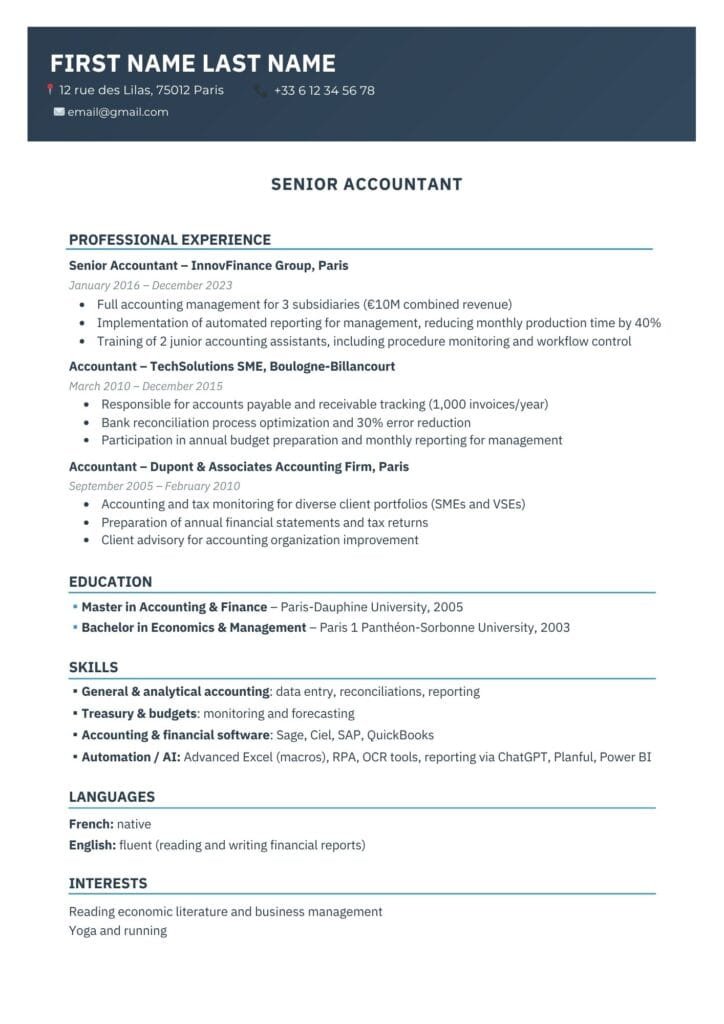Make the Perfect Resume
A good resume isn’t just a list of past jobs — it’s your entry ticket to new opportunities. It should make recruiters want to contact you… and pass the algorithm test. To get it right, follow three key steps: identify your strengths, tell a compelling professional story, and polish the layout.
Step 1: Identify Your Strengths and Talents
Before you start writing, you need to know what you really bring to the table. Sort your skills and classify them into hard skills, directly related to the job you’re targeting. That will help you position them right after your education and show how they connect to the role.
- Hard skills: measurable abilities (software, tools, languages, methods) a recruiter can immediately assess.
- Soft skills: interpersonal and behavioral abilities (adaptability, resilience, creativity, etc.). They don’t need to appear directly on your resume but should come through your experience, projects, and interests.
- Mad skills: unique or personal talents (side projects, hobbies, creative pursuits) that bring distinctive value — best mentioned subtly under “Interests.”
Listing your skills beforehand helps you understand your value and decide what deserves to appear on your resume. It’s also invaluable for interview prep.
Step 2: Tell Your Professional Story
Your resume should show what you’ve achieved and how you’ve grown.
👉 List your experiences in reverse chronological order, starting with the most recent one. This highlights your current level while revealing your progression and achievements over time.
- Key projects: describe the challenge, your actions, and concrete results. Example: “Managed a website overhaul project involving 5 teams and 3,000 clients.”
- Results achieved: numbers and measurable outcomes speak louder than vague words.
- Problems solved: show the challenge, your solution, and its impact on the organization.
- Add meaning to your journey: there’s always a common thread — key skills developed, recurring missions, or areas explored. Each experience should strengthen your value and trajectory.
If, like many people, you’ve taken a autodidact path, have a gap in your resume, or have simply moved forward by seizing opportunities as they came, don’t panic — that can actually become a real asset… provided you give it meaning.
Your common thread might be a key skill you’ve developed through different experiences, even across various industries. Maybe you’ve worked within the same field but in different roles? That gives you a valuable, well-rounded perspective. The goal is to demonstrate a sense of coherence, even if it isn’t immediately obvious.
You can also connect your experiences around a strong theme — project management, early childhood education, customer relations… Highlight the richness and diversity of your journey, rather than focusing on its apparent lack of direction.
Step 3: Design That Appeals to Humans… and Passes the Robots
A good resume isn’t just a record of your experiences — it’s a document designed for both busy recruiters and applicant tracking systems (ATS). It must be clear, well-structured, and built around specific sections.
The Visual Structure and Key Sections of a Resume
An effective resume follows how the human eye reads — in an “F” pattern. Place your contact details and key achievements at the top, where attention first lands. Stick to standard headings (“Professional Experience,” “Education,” “Skills”) and keep the design simple — ATS software struggles with fancy fonts or layouts.
Essential Sections
- Contact information: name, email, phone, and optionally LinkedIn profile at the top.
- Job title: the position you’re applying for.
- Professional experience: the core of your resume — highlight recent roles, main duties, and measurable results.
- Education: list degrees, certifications, and continuing education.
- Skills: prioritize keywords pulled directly from the job description (software, languages, technical expertise).
Optional Sections
- Profile / Summary: include only if it adds clarity — for instance, to explain a career change or emphasize a strong specialization.
- Interests: showcase what makes you unique outside work — volunteer work, creative hobbies, personal commitments. Avoid generic lists (“reading, travel, movies”) and choose two or three meaningful examples. Be cautious about mentioning activities that might conflict with the company’s values (for example, avoid listing hunting if applying to a vegan organization).
Showcase Your AI Skills
Today, being able to use at least one AI tool is a real advantage. Whether you use it to automate tasks, analyze data, or generate content, it shows curiosity, adaptability, and efficiency.
- Include tools under the ‘Skills’ section like ChatGPT or Gemini.
- Highlight them in your experience if you’ve used AI on specific projects — show real-world applications, not just buzzwords.
Which Tools to Use to Create Your Resume
Online generators often produce beautiful templates… that ATS software can’t read. The result: your resume may get rejected before anyone sees it. Personally, I stick with Word — it takes a bit longer, but you control every detail. Canva is fine for a quick start, but once you’ve got some real experience to fit in, it quickly becomes frustrating.
Sample Resume

Note: For speed, the layout of this sample resume was generated with Claude AI + Canva.
Take Action!
Your resume is your passport to interviews. It must be clear, impactful, and tell the story of your skills and achievements. With a bit of method and some clever tweaks, it becomes a powerful magnet for recruiters — and for ATS algorithms. Take the time to tell your story and show your value: the rest will follow!

❓ Frequently Asked Questions
Choose classic, readable fonts such as Arial, Calibri, or Garamond. Avoid decorative ones that hurt readability.
In France, one page is standard — except for senior professionals or complex career paths. Internationally, the rules are looser. Some highly specialized roles (researchers, executives, public servants — as with the Europass CV, strictly for the public sector and never for private companies) may require longer versions, but brevity is always a strength.
In France, photos are often expected. If you include one, make sure it’s professional and neutral. In the U.S. or U.K., photos are discouraged. That said, appearance bias exists — attractive men can benefit slightly, while attractive women may face envy. Unfair but real.
Use clear section titles, keep plenty of white space, and structure information so it guides the recruiter’s eye naturally.
Stick to 10–12 pt for text and 14–16 pt for section titles — legibility first.
Yes, sparingly. Choose neutral tones that express your personality without distracting from the content.
Proofread carefully — ideally multiple times or with a fresh pair of eyes. Even one typo can hurt your credibility. Don’t hesitate to use AI for that.
